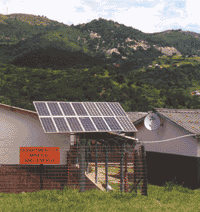by Jonathan
(Liverpool)

A SELF Project
The poorer the community, the greater damage it does to the natural world-trees being used as fuel and shelter, and burning animal manure for heat instead of fertilizer for the soil. In many areas south of the Equator, the absence of power condemns women and children to spend hours each day hauling water. In those places, a localized source of energy to run a simple pump could free thousands of people allowing time for other chores/activities. It also would ease the pressure on families to produce more children to share the chores and allow work to continue after nightfall.
SELF (The Solar Electric Light Fund, a non-profit organization) was founded in 1990 by Neville Williams, a former journalist who had promoted solar power in the US. By 1997, his modest operation had established eleven self-sustaining solar energy projects in countries across Asia, Africa, and South America.
In its early projects, SELF used funds donated by the World Bank, or loans from development agencies, to buy home-size solar cells in bulk on the open market. It then sold the systems at slight mark-ups to villagers in developing areas, usually forming a partnership with one of the country’s non-profit agencies. Each participating household made a 20% down payment on a system and was able to pay off the balance over several years. The buyers’ payments were pooled into a local loan fund from which their neighbors could borrow to buy their own solar power gear. SELF used a portion of the mark-ups on the equipment to establish a local dealership and trained local residents as solar installers and technicians.
This arrangement brought power to the people in more ways than one. They had electricity for their homes and farms with equipment that they had paid for themselves. The technicians learned a profitable trade that also ensured that the power systems’ continued operation didn’t depend on return visits from outsiders. The loan fund made it possible for villagers to finance the on-going supply of solar systems in their areas.
There have been broader benefits as well. In much of the developing world, the prime fuel for night lighting is kerosene. Every home burning the dim, kerosene-fuelled lamps puts an average of six tons of carbon dioxide into the atmosphere annually and exposes family members to fumes as harmful as smoking two packs of cigarettes a day. Now children in powered homes are able to study longer at night without eyestrain. And there is some evidence that birth rates decrease when people in rural areas have something to do after dark for example; watch television or listen to the radio.
SELF is now a largely recognized non-profit organization; designing and supplying sustainable energy solutions for developing countries. The use of solar technology allows for the country to grow in areas such as health, education, agriculture and economics without putting strain on the environment.
